Seventh Circuit Rules In Favor Of Transgender Student In Bathroom Access Case
A Federal appellate court has ruled that a transgender student must be allowed to use the bathroom that corresponds to their gender identity.
A three-judge panel of the Seventh Circuit Court of Appeals has ruled in favor of a Wisconsin transgender student who was suing his school district for the right to use the boys bathroom at his school:
A federal appeals court Tuesday issued a decision that could have far-reaching implications for transgender students, siding with a transgender boy whose Wisconsin school district had sought to bar him from the boys’ bathroom to protect the privacy of other students.
High school senior Ash Whitaker sued Kenosha Unified School District No. 1 last summer, arguing that its bathroom policy violated his civil rights. In a unanimous decision, a three-judge panel of the U.S. Court of Appeals for the 7th Circuit upheld a preliminary injunction that temporarily stops the district from enforcing that policy while the case is tried.
The school district’s privacy argument is “based upon sheer conjecture and abstraction,” wrote Judge Ann Claire Williams, while the harm that Whitaker suffered when he was prohibited from using the bathroom that matched his gender identity is “well-documented and supported by the record.”
Whitaker is set to graduate Saturday, so the concrete impact of this court victory on his school career will be limited. But advocates said the impact of the 7th Circuit’s decision could ripple far beyond Wisconsin at a time when the Trump administration has argued that decisions about accommodations for transgender students should be left to states and local school districts.
Whitaker argued that the school district’s bathroom policy violated his rights under the 14th Amendment of the U.S. Constitution and under Title IX, which prohibits sex discrimination in federally funded schools. The judges agreed, finding that Whitaker was likely to win his case based on that argument.
The decision makes the 7th Circuit the first appeals courtto interpret both Title IX and the Constitution as protecting transgender students from discrimination — and requiring schools to allow transgender students to use the bathroom matching their gender identity.
The decision sets a precedent in the 7th Circuit, which includes Illinois, Indiana and Wisconsin. Advocates say other appeals courts will take note.
“Other courts, as they will be grappling with these same issues, will hopefully find the 7th Circuit’s decision very persuasive as they look to answer these questions elsewhere,” said Joseph Wardenski, a Washington lawyer who, along with the Transgender Law Center, represents Whitaker.
Ronald S. Stadler, a lawyer for the school district, said he was “disappointed” in the decision, which he said suggests that the court “believes there is no harm in allowing men and women to use the same restroom.”
Stadler said the district is considering whether to appeal to the Supreme Court or ask a full panel of 7th Circuit judges to hear the case — or whether to proceed with the case in district court.
Importantly, the decision did not rely on or even mention the guidance to schools that President Barack Obama’s administration issued in May 2016, explaining the accommodations that schools must provide for transgender students to comply with Title IX.
The U.S. Court of Appeals for the 4th Circuit had relied upon that guidance when it ruled in favor of transgender teen Gavin Grimm, who challenged his Virginia school district’s policy banning him from the boys’ bathroom.
More from The Wall Street Journal:
Lawyers for the school district argued the bathroom policy protected the privacy rights of 22,160 students in the district, outweighing potential harms to Ash Whitaker, who has been diagnosed with gender dysphoria and began receiving hormone replacement therapy last year.
“A transgender student’s presence in the restroom provides no more of a risk to other students’ privacy rights than the presence of an overly curious student of the same biological sex who decides to sneak glances at his or her classmates performing their bodily functions,” wrote Judge Ann Claire Williams. “Common sense tells us that the communal restroom is a place where individuals act in a discreet manner to protect their privacy and those who have true privacy concerns are able to utilize a stall.”
Ronald Stadler, a lawyer for the school district, said the court created a new right “extending discrimination because of sex to now include the status of being transgender.”
“The Court believes there is no harm in allowing men and women to use the same restroom,” he said.
Federal courts disagree over whether transgender people can challenge bathroom policies under Title IX of the Education Amendments of 1972, which prohibits sex discrimination in educational programs, and other federal laws. At least one other federal appeals court and other federal trial courts have held they can’t. The Supreme Court may ultimately decide the question.
“A policy that requires an individual to use a bathroom that does not conform with his or her gender identity punishes that individual for his or her gender non-conformance, which in turn violates Title IX,” wrote Judge Williams, an appointee of President Bill Clinton.
She was joined by Chief Judge Diane Wood, another Clinton appointee, and Judge Ilana Rovner, an appointee of President George H.W. Bush.
This decision comes just under three months after the Supreme Court had sent a case dealing with a transgender student in Virginia back to the lower courts for further consideration. That move came just about a week after the Trump Administration had rescinded guidelines issued by the Departments of Education and Justice during the Obama Administration which interpreted Title IX of the Civil Rights Act of 1964 and the amendments that were made in 1972 to include discrimination against transgender students under the rubric of discrimination based on gender. Those guidelines were challenged by Texas and ten other states in Federal Court in Texas and placed on hold by a Federal District Court Judge, although that decision is effectively moot given the fact that the guidelines have been changed now that Obama is out of office.
While the Seventh Circuit didn’t mention either the original guidelines or the fact that they had been repealed, the analysis that the Court used in finding that Title IX covered discrimination against transgender students was basically identical to the analysis that the original guidelines as initially issued. As I’ve noted before, though, there are several things about that argument that are questionable at best. First of all, of course, that neither Title IX itself not the amendments make mention of discrimination based on sexual orientation or gender identity, which would seem to be a clear indication that neither of the two Congresses that passed these pieces of legislation intended to cover such discrimination when they passed the relevant legislation.
Until this Court decision, the only legal support for an argument to the contrary could be found in the Obama Administration guidelines that have now been rescinded along with a decision from the Fourth Circuit that largely relied on those guidelines for its decision, and it’s not at all clear that the legislation gives the Executive Branch the authority to expand the application of the relevant legislation. In fact, it was the central argument of the Federal Court ruling noted above that the Administration had exceeded the authority granted to it under existing law in issuing the guidelines in the first place. Outside of the problems surrounding the issuance of the guidelines, the actual state of the law is unclear, to say the least. The Fourth Circuit ruling on this issue was largely the same as that of the Obama Administration, for example, but other Federal Courts have ruled that current Federal laws such as Title IX may not apply to transgender students at all. Finally, the fact that previously passed civil rights laws don’t apply in situations such as this is arguably bolstered by the fact that many advocates for LGBT rights have been advocating for the passage of separate legislation that would expand those protections to cover sexual orientation and gender identity. If it were really the case that such discrimination was already illegal as a result of laws passed fifty years ago, then those laws, which have been enacted by many states and localities and proposed at the Federal level in such forms as the Employment Non-Discrimination Act would be entirely unnecessary.
In addition to ruling in the student’s favor on the Title IX arguments, the Seventh Circuit also addressed the claims made under the Equal Protection clause of the 14th Amendment, holding that he was likely to succeed on the merits in that argument as well. In doing so, the Court applied the same heightened scrutiny standard that gender-based generally receives under the Equal Protection Clause and found that the arguments made by the school district in favor of its policy requiring students such as the Plaintiff to use the bathroom corresponding to their biological gender rather than their professed gender identity did not meet that standard:
The School District defends its bathroom policy by claiming it needs to protect the privacy rights of all 22,160 students. The mere presence of a transgender student in the bathroom, the School District argues, infringes upon the privacy rights of other students with whom he or she does not share biological anatomy. While this court certainly recognizes that the School District has a legitimate interest in ensuring bathroom privacy rights are protected, this interest must be weighed against the facts of the case and not just examined in the abstract, to determine whether this justification is genuine.
What the record demonstrates here is that the School District’s privacy argument is based upon sheer conjecture and abstraction. For nearly six months, Ash used the boys’ bath‐ room while at school and school‐sponsored events without incident or complaint from another student. In fact, it was only when a teacher witnessed Ash washing his hands in the restroom that his bathroom usage once more became an issue in the School District’s eyes. And while at oral argument, the School District asserted that it had received just one complaint from a parent, this is insufficient to support its position that its policy is required to protect the privacy rights of each and every student. Counsel for the School District cited to Ash’s Amended Complaint for this assertion. The Amended Com‐ plaint, however, states that “some parents and other Kenosha residents began to speak out in opposition to Ash’s right to use the boys’ restrooms.” Am. Comp. ¶ 77. It further states that several community members spoke at a School Board meeting and voiced their opposition to a policy that would allow transgender students to use gender‐appropriate restrooms. See id. (“One parent told the Board that he was op‐ posed to permitting transgender students to use gender‐appropriate restrooms … .”). Nonetheless, neither party has offered any evidence or even alleged that the School District has received any complaints from other students. This policy does nothing to protect the privacy rights of each individual student vis‐à‐vis students who share similar anatomy and it ignores the practical reality of how Ash, as a transgender boy, uses the bathroom: by entering a stall and closing the door.
A transgender student’s presence in the restroom provides no more of a risk to other students’ privacy rights than the presence of an overly curious student of the same biological sex who decides to sneak glances at his or her classmates performing their bodily functions. Or for that matter, any other student who uses the bathroom at the same time. Common sense tells us that the communal restroom is a place where individuals act in a discreet manner to protect their privacy and those who have true privacy concerns are able to utilize a stall. Nothing in the record suggests that the bath‐ rooms at Tremper High School are particularly susceptible to an intrusion upon an individual’s privacy. Further, if the School District’s concern is that a child will be in the bathroom with another child who does not look anatomically the same, then it would seem that separate bathrooms also would be appropriate for pre‐pubescent and post‐pubescent children who do not look alike anatomically. But the School District has not drawn this line. Therefore, this court agrees with the district court that the School District’s privacy arguments are insufficient to establish an exceedingly persuasive justification for the classification.
To the best of my knowledge, this is the first time that the rights of transgendered have been addressed as part of a 14th Amendment argument rather than a statutory one, and that could be significant on appeal. For one thing, while the panel does group discrimination against this student based on their gender identity under the rubric of “gender” discrimination, that doesn’t carry with it the same potential problems with it that the similar analysis under TItle IX does. This is because the Fourteenth Amendment in general, and the Equal Protection Clause in particular, don’t mention any particular categories to which they apply, largely because it’s clear that the drafters of the Amendment intended for it to cover all Americans rather than just the issue of racial discrimination that was the primary concern in the post-Civil War context in which it was enacted. Over the years, though, the Courts have ruled that the clause applies far beyond just the issue of race-based discrimination and covers nearly any kind of difference between people that may be treated differently under the law.
Over the years, this has meant that, over the years, the Equal Protection Clause has been found to cover discrimination based on race, religion, ethnicity, gender, and other categories. The only difference is that the Court has held that forms of discrimination must sometimes be judged based on different levels of scrutiny. For categories such as race and ethnicity, courts generally apply a level of review known as “strict scrutiny,” which requires that a law found to be discriminatory on one of these bases can only survive review if it serves a compelling government interest, is narrowly tailored, and is the least restrictive means for achieving the government’s stated goal. One step below that is “heightened scrutiny,” which applies to gender and some other forms of discrimination, which requires that “the law or policy being challenged furthers an important government interest by means that are substantially related to that interest.” Finally, those laws that don’t fall under either of the two preceding tests are judged based on what’s called the “rational basis test,” which means the government law or policy being challenged can stand if it meets some rational basis. As noted, in this case, the court applies the “heightened scrutiny” challenge, but one could argue that the school district’s policy cannot even be justified under the rational basis test since there’s no evidence that a transgender student in the bathroom of the gender they identify with violates the rights of fellow students or puts them in any danger. If this argument stands, then the weaknesses of the Title IX analysis would be largely moot, and transgender rights would be significantly better served than they would be by a statutory analysis that is, to be honest, rather weak.
In any case, from here this case can go one of two ways. Either the school district can seek a rehearing before the entire Seventh Circuit Court of Appeals, or it can seek Supreme Court review of the case. If the Court took the case, it would be set for argument at some point in the term that will begin in October of this year and would immediately become among one of the the most high-profile cases on the Court’s docket for that term.
Here’s the opinion:
Whitaker v, Kenosha Unified School District by Doug Mataconis on Scribd
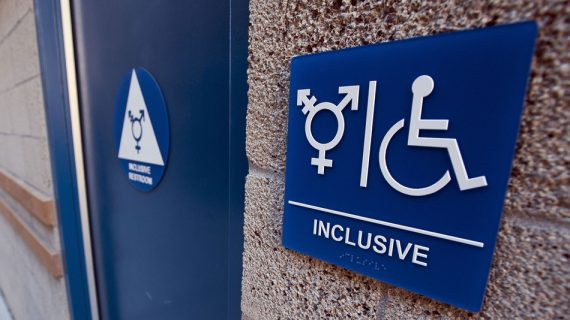

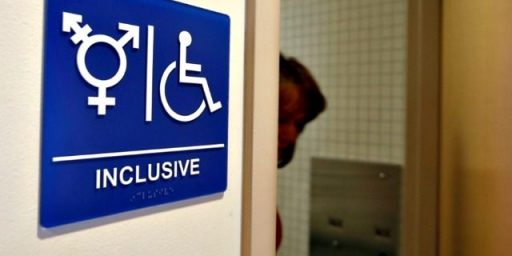
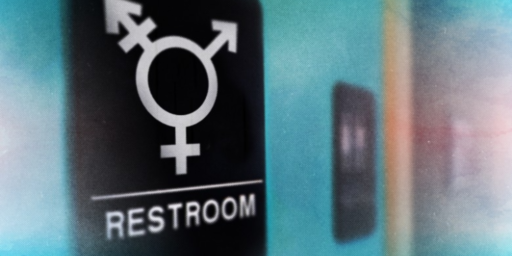
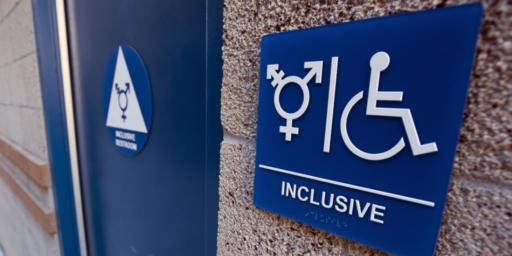
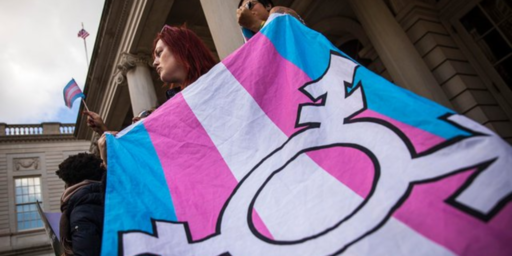
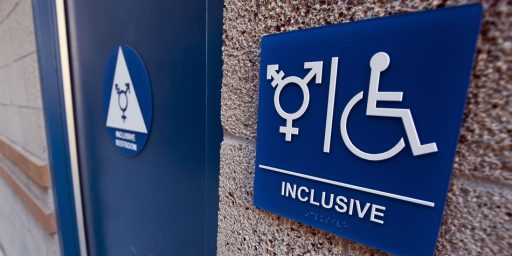
Good.
Or they could just drop it, which is probably what they should do.
Interesting about this:
I watched a video last night about a campaign to convince Indian men to build toilets for their homes, so they don’t have to shit in the bushes by the river. Compared to that, our bathroom problems don’t even seem like problems.
@James Pearce:
When I was stationed in Japan, it was common, especially in the rural areas, to have unisex bathrooms. A little startling at first, but not a big deal. It is performing a basic biological function. Basic manners dictated that you don’t notice.
I keep pointing out to my conservative friends that they are arguing for bearded transgender men to be in the ladies’ room simply because they were born with a particular set of genitalia.
I am now convinced that conservative CIS females want their own bathroom, and the men’s room is for everyone else.
This is probably over exaggerated, overblown, hyped, and sensationalized. I have researched some past histories, stats, and accounts concerning restroom dangers. People are in more danger of slipping and falling on wet restroom floors than they are of some creep in the restroom after them. That is not to say that there aren’t some nuts out there, but most people go into the public restrooms, use it and get out without a second thought.
Most women can’t stand the thoughts of going into a men’s restroom (it’s the toilet seats, and men don’t aim good). I remember several times where I have been at some crowded event and the women’s restrooms always had a long line, much longer than the men’s. I have always wondered why that is. Sometimes the men will hold off and let the women use the men’s restrooms to cut down the wait, but some women won’t take the offer. I hear complaints all the time from women about the mens rooms being filthy; and I have to agree.
Signs in restrooms:
“Plumbing fixtures installed and maintained by
Harry Plushbottoms and Sons Plumbing Co.
“Restroom inspected by Fred Philpott, county health inspector”
“Restrooms cleaned and sanitized by T. T. Johnwater Co.”
Restroom reading materials:
“Diary of a Leaky Restroom”
“Under the Stalls” by Seymore Butz
“Bathroom Games” by John Komode
“Uncle Johns Unsinkable Bathroom Reader”
The 3 judges are idiots. They are really stretching if they think SEX is the same as gender confusion which should be a mental illness. This will be overturned. Those idiot judges on the 7th circuit are ruining the states of WI, IL and IN. This battle is far from over. And SSM will be reversed too at the federal level, in the future.
@Tyrell: Yeah, the women’s facilities are filthy as they make quite a mess.
@Tony W: Females with a fake beard need to stay in the female facilities. Don’t spin it again.
@Scott: We’re talking about MINORS here. Have some decency.
@James Pearce: No, no drop in this case. Split in the courts will take it to the next level. The 7th circuit has dummy judges so they will need to be reversed for their inept ruling.
@iSeeDumbPeople: Bad, needs to be reversed.